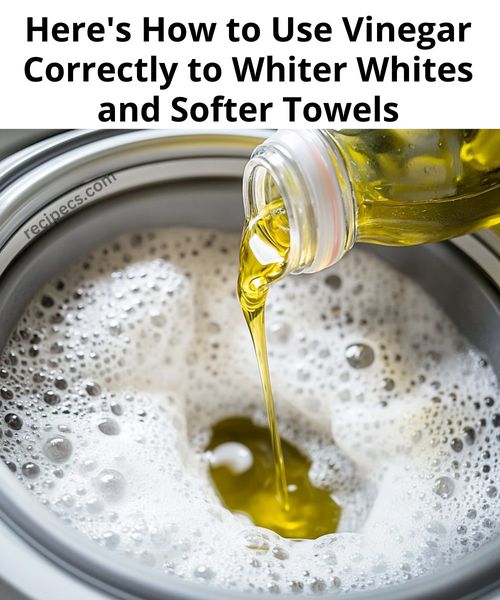Vinegar is a versatile household staple, widely recognized for its uses in cooking, cleaning, and even as a natural remedy. However, one of its most effective applications often goes unnoticed—enhancing your laundry routine. Imagine achieving brilliantly white clothes and luxuriously soft towels without resorting to expensive, chemical-laden detergents or fabric softeners. The secret? Vinegar. This article will guide you on how to incorporate vinegar into your laundry routine effectively, ensuring whiter whites, softer towels, and a fresher overall clean.
Why Use Vinegar in Your Laundry?
Before we dive into the step-by-step guide, let’s explore why vinegar is such a powerful laundry ally. Distilled white vinegar contains acetic acid, a mild yet effective agent that breaks down dirt, softens fabric, and neutralizes odors. Unlike bleach or commercial fabric softeners, vinegar is gentle on fabrics and leaves no harmful residues. Plus, it’s eco-friendly, making it an excellent choice for those looking to reduce their environmental impact.
Key Benefits of Using Vinegar in Laundry
- Natural Bleaching Agent: The acetic acid in vinegar brightens whites without the harshness of bleach.
- Fabric Softener Alternative: Vinegar helps remove detergent residues that can cause stiffness, leaving your towels and clothes soft and fluffy.
- Odor Elimination: Vinegar neutralizes unpleasant odors, ensuring your laundry smells fresh.
- Color Brightening: It prevents colors from fading by dissolving alkaline deposits left by detergents, preserving the vibrancy of your clothes.
How to Use Vinegar for Whiter Whites and Softer Towels
Now that you understand the benefits, here’s how to use vinegar effectively in your laundry routine.
1. For Whiter Whites: Add Vinegar During the Rinse Cycle
To achieve whiter whites, add 1 cup of distilled white vinegar during the rinse cycle. This timing is essential, as adding vinegar during the wash cycle can diminish its effectiveness. The rinse cycle allows vinegar to act on any leftover detergent residues or mineral deposits that dull your whites.
Pro Tip: Avoid using vinegar in the same cycle as bleach or other chemical whiteners to prevent adverse reactions that may lessen the effectiveness of both agents.
2. For Softer Towels: Use Vinegar Instead of Fabric Softener
Towels can become stiff and scratchy due to detergent buildup over time. Adding ½ cup of distilled white vinegar during the rinse cycle dissolves detergent residues, leaving your towels softer and fluffier.
Pro Tip: For extra softness, soak your towels in a vinegar solution (1 cup of vinegar in a bucket of water) for 30 minutes before washing. This deep-cleansing soak revitalizes old, rough towels.
3. For Stain Removal: Pre-Treat with a Vinegar Solution
For stubborn stains, create a mixture of 1 part vinegar and 1 part water and apply it directly to the stain. Let it sit for 10-15 minutes before washing as usual. The acetic acid in vinegar helps break down stain particles, making them easier to lift during washing.
Pro Tip: This method is particularly effective for coffee, tea, sweat, and deodorant stains. For tougher stains, add a small amount of baking soda for an extra boost.
4. For Removing Mildew: Soak Towels in a Vinegar Solution
If your towels smell musty or have developed mildew, soak them in a solution of 1 cup of vinegar and 1 cup of water for 1 hour before washing. Vinegar’s antifungal properties help eliminate mold and mildew, refreshing the fabric.
Pro Tip: After soaking, wash the towels with your regular detergent and add another ½ cup of vinegar during the rinse cycle for maximum freshness.
Avoid Common Mistakes When Using Vinegar in Laundry
While vinegar is a fantastic laundry booster, using it correctly is essential for the best results. Here are common mistakes to avoid:
1. Using Too Much Vinegar
More is not always better. Excessive vinegar can weaken fabrics over time, especially natural fibers like cotton and wool. Stick to recommended amounts (1 cup or less) to avoid damage.
2. Mixing Vinegar with Bleach or Other Cleaners
Never mix vinegar with bleach or ammonia-based cleaners. Doing so can produce toxic chlorine gas, which is harmful to inhale. Always use vinegar as a standalone additive or pre-treating solution.
3. Using Vinegar on Delicate Fabrics Without Testing
While vinegar is safe for most fabrics, delicate materials like silk or rayon can be sensitive to acetic acid. Test a small, inconspicuous area first to ensure there’s no discoloration or damage before using vinegar on the entire garment.
4. Adding Vinegar Too Early in the Wash Cycle
Adding vinegar during the wash cycle while detergent is still active can neutralize some of the detergent’s cleaning power. Always add vinegar during the rinse cycle to maximize its benefits.
How Often Should You Use Vinegar in Your Laundry?
Incorporating vinegar into your laundry routine once a week is typically sufficient for maintaining softer, fresher-smelling fabrics. If you deal with particularly hard water or stiff towels, consider using it every wash.
Final Thoughts: Why Vinegar Is a Game-Changer for Laundry
Using vinegar in your laundry is a simple yet effective way to achieve cleaner, brighter, and softer fabrics. It’s a cost-effective and environmentally friendly alternative to traditional bleach and fabric softeners. By following the right techniques and avoiding common mistakes, you’ll unlock the full potential of this household staple and transform your laundry routine.
Give these methods a try and witness the difference for yourself. You’ll be amazed at how a small change can lead to whiter whites, softer towels, and an overall fresher laundry experience!
